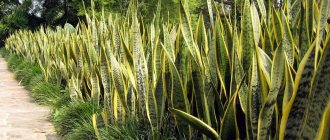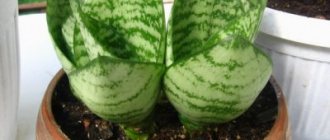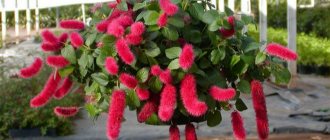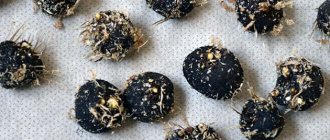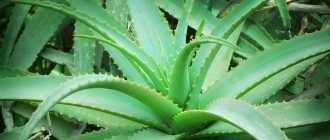What kind of soil does sansevieria need?
The plant does not like acidic soils - the skin on the flower cracks due to the high nitrogen content. The best option is soil with a neutral pH (6-7). The loose, light structure provides good aeration to the roots.
Sansevieria
The substrate for transplanting sansevieria is prepared according to the following recipe:
- add the same amount of sand to the 1st part of peat;
- add 3 parts of turf or leaf soil, as well as ½ part of humus;
- add a little vermiculite or perlite to the mixture (to absorb excess moisture);
- the substrate is poured into a pot and used to transplant the flower.
You can also take a different soil composition: from sand, deciduous and turf soil in a ratio of 2:2:6, respectively.
Ready mixes
Although professional gardeners prefer to prepare soil for planting themselves, commercially available soil for succulents is quite suitable for amateurs . The composition of this soil is based on peat. It can be high and low.
High-moor peat is very light and poor in nutrients and can retain moisture for a long time. Lowland peat is heavier, it cakes quickly, which is why sand is often added to it.
The price of ready-made soil for succulents in Moscow is about 80 rubles . In St. Petersburg, the price is approximately the same and can vary greatly among different manufacturers.
Nitrogen fertilizers harm succulents, so it is better to use potassium fertilizers. As a top dressing, you can buy ready-made mixtures.
Sansevierias do not like a lot of moisture; frequent watering harms them and triggers putrefactive processes, so you need to water the ground no more than once a week. You also need to avoid getting moisture on the leaves of the plant. In winter, it is worth watering the soil about once a month.
Although Sansevieria does not require special soil, it is still useful to know what kind of soil this plant thrives on, how to prepare the soil and care for it. The better the plant is cared for, the better it will develop and delight the owner with striped green leaves.
If you find an error, please select a piece of text and press Ctrl+Enter.
How fast does Sansevieria grow?
The question of how to transplant a pike tail rarely arises among gardeners - this plant develops very slowly. It would be more relevant to ask when this procedure should be performed.
Pike tail flower - care and reproduction
Mother-in-law's tongue (another name for the plant) can develop freely in one container for 2-3 years. Time is not a reason to move. The signal for a transplant will be the following moments:
- separate rosettes have formed on young leaves;
- the plant is cramped, roots are visible from the drain hole at the bottom of the pot;
- Sansevieria began to wither, turn yellow, curl up, curl up.
Note! The latter reason is often provoked by improper care, leading to rotting of the roots. To verify the condition of the underground part of the plant, it will have to be removed from the pot. Having tidied up the roots, it is wiser to immediately allocate a new container for the pike tail.
Transfer rules
Mother-in-law's tongue flower - home care
If you ignore the plant's signals that it is time to change the pot, it will continue to develop and begin to become deformed. In order for Sansevieria to feel comfortable, transplantation at home is carried out in compliance with the requirements:
- in pike tail, the roots are located close to the surface, so when choosing a container, take into account not the depth, but the width;
- the new pot should be only 10% larger than the previous one - the root system of this plant likes close quarters;
- The stability of the container is important - Sansevieria is a heavy plant (especially tall species).
Transplanting into a new pot
Note! The material from which the pot is made also matters. To prevent the container from bursting under the pressure of the roots, it must have thick walls. Therefore, it is better to take a clay container for the flower.
The importance of making the right choice
Sansevieria is distinguished by its unpretentiousness and ease of maintenance. The complex name of the flower is not familiar to every lover of indoor plants; more common ones are: mother-in-law’s tongue, snake skin, pike tail. Belongs to the Asparagus family (according to some sources, Agaveceae), it received its popular names due to its dense, long striped leaves.
For pike tail, ready-made soil is suitable; you can buy soil for succulents at a flower shop or prepare the mixture yourself. Drainage is required in the pot; it should occupy at least a quarter of the container.
How to plant pike tail at home
Sansevieria does not have a dormant period, so the time to move to a new container can come in any season. Having prepared the pot and soil, study the algorithm on how to transplant sansevieria correctly:
- taking a knife in your hand, run its blunt side along the inner wall of the pot - this will make it easier to remove the flower;
- the pike tail is placed in a basin and the old soil is washed off from the roots with a stream of water;
- the bottom of the new container is covered with expanded clay, on top of which a 1/3 layer of fresh substrate is poured;
- Place the plant in the center, carefully leveling the roots;
- pour a little earth around the flower and compact it.
Gatsania flower - how it blooms on a club, what soil is needed for growing
The last step is repeated until the container is filled with soil. In this case, each layer is slightly moistened with water at room temperature.
Important! When replanting sansevieria, take into account the size of the plant. If the bush is several years old, it has tall, heavy leaves. Therefore, while rooting in the new pot, the pike tail will need reliable fixation.
Pike tail flower
This plant has many names. It is possible that at the beginning, you will not even understand that we are talking about your pet flower called “pike tail”. You can also hear that it is called: “cuckoo tail”, “Indian sword”, “snake braid”, “devil’s tongue”, “mother-in-law’s tongue”, and in scientific terms it is even more complicated - sansevieria or sansevieria.
About the features of Sansevieria
According to signs, the pike tail flower brings many benefits and is a useful and irreplaceable plant.
- Sansevieria helps householders deal with stress. Strengthens fortitude and teaches you to look at life philosophically.
- Charges the air with health, strengthening the body against colds and other diseases.
- It helps people who are seismically dependent to more easily endure various solar flares and changes in the atmosphere.
- Household members become more patient and cope with difficulties more easily.
- Students, and even ordinary schoolchildren, learn new knowledge more easily and quickly.
- In case of possible conflicts and quarrels, this plant will smooth out the negative, while allowing a small dispute not to develop into a scandal.
- Sanseviera will also help out people who are unsure of themselves and will help them become independent from outside opinions.
- This flower is also very useful for the stronger sex, it instills courage, bravery and improves male potency.
- In addition to everything described, sansevieria perfectly purifies the air from bacteria, germs and all kinds of negative emotions that try very hard to wedge themselves into our daily lives.
How to care for a pike tail flower?
You will be very surprised to learn that the pike tail flower requires virtually no care! Its main requirement is warmth. The room temperature should not be lower than 15°C. Like many other plants, Sansevieria does not tolerate direct exposure to sunlight. Some gardeners have noticed that pike tail can generally do without sunlight for a long time.
How to water a pike tail?
It is precisely in watering that the whole basis of proper care lies. Sansevieria really doesn't like standing wet. It should be watered only when the top layer of soil is completely dry. In winter, the intervals between watering can be from 2 to 3 weeks.
When watering a flower, make sure that the water gets directly into the ground. It is best to protect the leaves from excess moisture. Periodically, simply wipe it from dust with a damp cloth.
How to transplant a pike tail?
Replanting a pike tail is required extremely rarely, only if you want to see a new bush, or if it accidentally overflows. This plant thrives in cramped pots. Have you decided to replant your pet? Then remember a simple algorithm:
- Sansevieria does not need to be watered before transplanting;
- Gently tap the pot on the floor so that the soil moves away from the walls;
- pull the flower out of the ground by its dense leaves;
- In a prepared, preferably an elongated pot, add drainage - expanded clay or pebbles (don’t forget about the holes for water), add regular soil for plants on top and feel free to plant your “tail”;
- On the first day, do not water, limit yourself to just spraying the soil.
Reproduction of pike tail
Don’t be surprised, but everything here is also quite simple. You can try planting a regular leaf in the ground. The cutting method is also very popular: the leaf is cut and buried in damp sand to a depth of 2-3 cm. In a month and a half, you will see the results.
Pike tail bloom
There are about 70 varieties of piketail known in nature, and almost all of them are flowering plants. Those who have seen this flower during the flowering period note the bright aroma of vanilla, which intensifies significantly at night. Such a pleasant surprise awaits those who make friends with this plant.
Sansevieria propagation
If the time to plant mother-in-law's tongue was in the spring, you can combine this procedure with propagation. During this period, all biological processes are proceeding at an accelerated pace; the active movement of juices will help the plant take root faster.
Novice gardeners are interested in the question of how Sansevieria reproduces. This activity is carried out in several ways:
- division of rhizomes;
- cutting off side shoots;
- fragments of a leaf plate.
The latter option does not allow preserving the color of some types of pike tail, but the method still remains popular. This method is especially good if the root system has become sick and unusable.
Preparing for transplant
Leaf
You can also use the propagation of Sansevieria by leaf in the case when an already formed plate breaks off. At the same time, mother-in-law’s tongue can be rooted both in the soil and in a cylindrical container with water.
The soil
In order for Sansevieria to take root, propagation by leaf is carried out in a soil other than that intended for replanting the flower. In this case, the loose substrate should contain components in the following proportion:
- 1 part of sand and humus;
- 2 parts each of turf and leaf soil;
- The presence of charcoal is required.
Another composition is also suitable for propagation: from leaf and turf soil with the addition of perlite (all ingredients are taken in equal parts). The soil must be sterile (calcined) and moist before planting.
What kind of pot do you need?
The rules for choosing a container for a pike tail were mentioned above. The cuttings with which the plant will be propagated are small in size. Therefore, you should not take a spacious pot. For starters, a container no more than 8 cm in diameter and about 5-6 cm deep is quite suitable.
As for the material of the pot, it must be breathable so that future roots can breathe. Ceramics (clay) are best suited for this. In addition, it perfectly absorbs water, acting as additional drainage.
Agricultural technology
To know how to properly propagate sansevieria by leaf, follow the step-by-step instructions. At the same time, despite the general aspects, there are differences in earth and water rooting.
Leaf propagation
First perform the following actions:
- cut a healthy, undamaged leaf from the mother bush;
- the plate is cut into strips of 10-15 cm, moving with a sharp knife perpendicular to the veins;
- On each fragment, the bottom and top are marked with a marker (this is important when planting).
Important! If part of the plate is buried in the ground or lowered into water with the wrong cut (against the flow of juices), you may not expect roots.
Peculiarities of propagation of Sansevieria by leaf
| In the ground | In water |
|
|
Planting leaf parts directly into the substrate is preferable - rooting will occur faster (in 1.5-2 months). New shoots from the leaf can be expected in 7-8 months. For this to happen, optimal conditions are maintained:
- air temperature – within 21-25°;
- luminous flux - only diffused;
- substrate – moderately moistened (watering through a tray).
Note! When propagated by leaves of mother-in-law's tongue, some gardeners practice the greenhouse effect. It is undesirable to do this - due to increased humidity, the cuttings may rot.
Why remove the growing point of Sansevieria?
The goal of propagation is not just to get a new plant, but also to preserve all its characteristics. Not every method satisfies this desire. In varieties with variegated leaves, color can only be preserved by propagation by layering.
The older the plant, the less likely it is to get planting material from it. After 5 years, the flower practically does not form root layers. To stimulate the queen cell to develop, you need to carefully cut out (not twist) the growth point and remove the top 2-3 leaves.
Sansevieria with layerings
The plant will immediately redirect its forces to the development of the rhizome; after 1.5 months, several good layering will develop on the bush. They are cut off and planted in pots. After this, an adult Sansevieria can grow for several more years (until the foliage dies).
If you are unable to grow floriculture, grow sansevieria
The air temperature in the room where the flower grows should be within +18-25°C, and in winter the temperature is reduced to +15°C.
There is no need to spray the plant; it is enough to periodically wipe its leaves with a damp cloth. You can water it once a week - not before the soil in the pot dries out. During the wintering period it is necessary to water once every three weeks. And only if the air temperature drops and the light level decreases.
It is necessary to feed the plant no more than once a month, and during the dormant period it is not required at all. Transplantation is carried out in the spring, when the container becomes crowded. This should be done no more than once every 2-3 years.
Sansevieria cylindrical - reproduction
The plant can be propagated by cuttings, rhizome division, leaf cuttings and secondary rosettes. The plant takes root so easily that you can simply stick a broken leaf into sandy soil and sprinkle it with coal. In general, Sansevieria is great for beginner gardeners.
Sansevieria is an evergreen, stemless, evergreen, perennial, herbaceous plant of the Asparagus family. In the wild it grows in the tropics and subtropics of Africa, India, Indonesia, Madagascar and South Florida. In Russia, Sansevieria is an indoor flower, an inhabitant of window sills, grown at home, and does not require special care.
The indoor flower Sansevieria has several names - mother-in-law's tongue, pike tail, snake skin. In Germany the plant is called African hemp, and in England devil's tongue or leopard lily.
Opinions about the magical abilities of sansevieria among different peoples are very opposite. In those countries where the plant is called the devil's or mother-in-law's tongue, they are sure that it provokes quarrels and misunderstandings in the family. And in China they say that Sansevieria, on the contrary, absorbs all the negativity that appears in the house.
Sansevieria three-lane.
As for the ability to absorb negativity, the issue is controversial, but science knows that an indoor flower can absorb moisture from the surrounding air; this plant is a succulent, so caring for it does not take much time.
In addition, the flower is capable of releasing large volumes of oxygen, destroying bacteria and purifying the air from harmful gases, neutralizing fumes from furniture and finishing materials and radiation from electronic equipment that are dangerous to humans. Thanks to these actions, a person living in the same living space with sansevieria increases immunity and improves overall health. Thus, we can safely say that Sansevieria growing at home also provides a kind of care for its owners.
Infusions and decoctions of sansevieria help with inflammation of the female genitourinary system, inflammation and ulcers of the skin, and otitis media. The smoke from burning dry leaves is used to treat headaches.
It should not be forgotten that Sansevieria contains toxic substances, so the plant must be treated with extreme caution.
Sansevieria has straight, lanceolate, tall leaves up to two meters long, which grow from rosettes. There are 6-8 leaves in one rosette. In spring, the plant throws out a peduncle, on which small white flowers appear with a pleasant aroma, which intensifies in the dark. Actually, the flowers of different varieties of sansevieria can be different - bright and beautiful, or vice versa - discreet, but they all exude a pleasant vanilla scent.
In nature, there are about 70 species of this plant; some of them are most often grown at home: Sansevieria three-lane, Sansevieria cylindrical, Sansevieria hanni.
Three-lane sansevieria (sansevieria trifasciata) is a wild species found in a semi-desert climate zone, so it does not like heavily moist soil and stagnant water.
At home, Sansevieria trifasciata grows up to 1 meter in height. The leaves of the plant are lanceolate and vertical. The leaf color is green with dark stripes of a light shade. The flowers of Sansevieria three-lane are similar in structure to futura and greenberry.
Caring for a pike tail will not be difficult even for a busy housewife. Sansevieria trifasciata is a southern and light-loving plant, but it can do well without natural light. To create comfortable conditions, artificial fluorescent lamps or special phytolamps are enough for her.
Sansevieria is also undemanding when it comes to watering - after all, under natural conditions it grows in arid regions. In summer it can absorb moisture from the air, but in autumn and winter during the dormant period it does not need frequent watering at all. Excessive moisture and excessive watering will lead to the death of the sansevieria; its roots begin to rot. In winter it is watered once a month, and in summer - once a week.
The plant does not require care.
The only requirement of a flower for growing conditions is warmth. The sansevieria may die from the cold, but first it will show its dissatisfaction by the fact that its leaves will become pale. Therefore, it is best to grow it in a bright room with windows facing sunny sides - to the west or east. The pot does not have to be placed on the windowsill; the flower will be comfortable on a shelf or on a special stand located in the back of the room.
The air temperature for sansevieria should be within 16-26 degrees; it does not have a dormant period, so it is not necessary to reduce the air temperature in winter. At the same time, the flower can easily withstand a short-term drop in temperature to +5 degrees, after which it must be transferred to a warm place.
In the warm season, the pot with sansevieria is taken out to the balcony or outside, and first placed in a shaded place for adaptation. After some time, it can be moved to a more illuminated place.
The air humidity for the flower should not be too high, but if it stands indoors all summer, the air around it should be moistened with a spray bottle. In addition, wipe the leaves from dust with a damp sponge or wash them in the shower - these procedures will also have a refreshing effect on the flower.
If water gets into the rosette of leaves during the procedure, you should try to remove it from there so that it does not become a breeding ground for fungus.
Caring for sansevieria at home involves using soil suitable for the plant. In this case, a mixture for deciduous and flowering indoor plants, sold in finished form, would be suitable. In addition, the substrate can be made independently from turf and leaf soil, fibrous peat substrate, river sand - they are taken in equal quantities. At the bottom of the pot there must be a layer of drainage made of pebbles, expanded clay or broken brick.
The plant does not have to be replanted too often if the roots do not grow too much; replanting is done once every three years - in the spring. The new pot should not be much wider than the previous one; in some cases, replanting comes down to removing part of the root system and children, replacing the soil and returning to its original place. Sansevieria tolerates transplantation well, and separated children can be used for propagation.
The pot for replanting should be shallow but wide - the roots of the flower grow in different directions. They are so strong that they can crack a plastic pot if they get too crowded. Therefore, it is better to take a ceramic and durable pot for sansevieria, and replant it in time, without waiting for the “escape”.
If you want to admire the flower of mother-in-law's tongue, do not rush to replant it in a spacious container - it more readily throws out the peduncle when the roots have nowhere else to develop.
Sansevieria is fed with complex mineral fertilizers once a month - excess or lack of fertilizers can cause poor leaf growth and blurred leaf patterns.
If Sansevieria does not grow
The simplest reason why the mother-in-law's tongue stopped developing is the excessive crampedness of the potty. If a young plant has stopped growing, you should pay attention to the care conditions:
- improper watering;
- bright sunlight or shading;
- low temperatures;
- draft.
All these factors not only slow down development, but also become causes of Sansevieria disease. The plant itself will signal the problem.
Pike tongue has soft leaves
First, the plates begin to turn yellow, then soften at the base. The situation is caused by waterlogging of the soil. The only way to really save the situation is by transplanting it into a new pot. To do this, perform the following steps:
- the flower is carefully removed from the container;
- the roots are freed from the ground and inspected;
Note! If the root system has rotted, there is no point in resuscitating the entire plant.
- soft yellow leaves are removed.
Fresh soil is poured into a new container and the sprout is planted in it. The pot is placed away from the sun's rays and the watering regime is monitored.
Why do Sansevieria have limp leaves?
The opposite situation, when the soil is too dry, leads to lethargy of the plant (especially if the room temperature is below +15°). A quick way to bring Sansevieria to life is to move the pot to a warm place, remove the flaccid plates and water the soil.
Mother-in-law's drooping tongue
If signs of trunk rot are noticed, it is better to cut off the undamaged parts of the leaves and root them in a new container. Throw away the remains of the diseased plant.
Other developmental problems
Sansevieria, like cactus, does not like frequent watering. Excess moisture, as well as violation of other regimes, lead to serious deviations in the development of the pike tail.
How to fix sansevieria problems
| Sign | Cause | Recipe for resuscitation |
| Twisting | Leaves may curl due to lack of moisture | It is enough to establish regular, but not frequent watering, and the plant will stop curling |
| Rugosity | Affected by prolonged exposure to shade and lack of moisture. | The light regime is corrected by gradually moving the pot towards the window. After this, watering is adjusted |
| The leaves have fallen | Evidence that the plant is cold | It is enough to move the flower to a warm room, and the foliage will quickly straighten |
Knowing what sign indicates a problem, it is easier to understand why Sansevieria leaves curl (wither, turn yellow, etc.). This will allow you to provide first aid to the plant in time and establish proper care.

